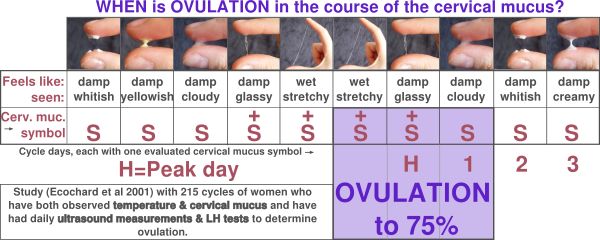This is probably one of the biggest questions of humanity: “When is ovulation?” Maybe you’re asking yourself, “When is my ovulation?” The answer you will get in this article.
Most women think that it is possible to calculate the time of ovulation, but that is not right. The natural cycle is simply subject to many fluctuations that make calculating ovulation too inaccurate. In the last post on my pregnancy cycle it was clearly shown that with the “Sex according to an ovulation calculator” approach, I probably would not have become pregnant so simply. From a medical standpoint, you can only use ultrasound or body observation to answer the question: “When is ovulation?” reliably. Since most do not have an ultrasound device nearby daily, I would like to show you how you can easily determine your ovulation by body observation from home.
Determine ovulation based on body signs
Ovulation can best be determined by means of body signs for the current cycle. Study results show that ovulation with the Symptothermal method can be precisely limited to about four days. I would like to explain briefly how this works.!
Observe your cervical mucus
When you observe your cervical mucus at the vaginal entrance every day, you will find that both its appearance and consistency change over the course of the cycle. As a rule, the water content in the mucus increases significantly until ovulation. A typical cervical mucus course is shown in the graph below. Initially, the cervical mucus is sticky and whitish here. The closer to ovulation, the cervical mucus becomes more and more transparent. After ovulation, the water content in the cervical mucus decreases again, so that the mucus becomes sticky and whitish or no longer visible.

We refer to the last day on which the cervical mucus has the best individual quality as the cervical mucus peak (H). The cervical mucus is considered to be evaluated if the mucus quality is less than at the peak at least three days after the peak of the cervical mucus. For this reason, the days after the cervical mucus peak are denoted by the numbers 1,2,3. It should be said at this point that each woman has her own cervical mucus history, which can vary each cycle, and moreover several cervical mucus peaks can occur in the cycle. In order to really know when ovulation is over and whether ovulation has taken place, it is, therefore, necessary to measure the basal temperature in addition and to really deal with the rules of the Symptothermal method.
Measure your basal body temperature
Shortly after waking up and before getting up, you can measure your basal body temperature, eg. with a digital basal thermometer with two decimal places for three minutes under the tongue (oral). If you do this every day for a cycle, you will get one measurement point for each day. If you connect these measuring points, you will get your basal body temperature curve. Shortly after ovulation, the basal temperature curve increases slightly by about 0.2 to 0.5 °c compared to before and is increased until the next menstruation or birth. The temperature can, therefore, tell when the ovulation started and the cervical mucus indicates that ovulation will soon be. Thus, the double evaluation of the fertility signs, cervical mucus and basal body temperature, ovulation is limited to a few days.
The temperature rise is determined in the simplest case with the 3 over 6 rule. This means that in the basal temperature curve there are three temperature measuring points that are higher than the 6 preceding temperature measuring points. The first increased measurement of basal body temperature is also called the first higher measurement. The third higher measurement must be at least 0.2 °c higher than the 6 lower values for the evaluation. The elevated temperature values are marked (see example: triangles) and the six lower values are marked with digits from 1 to 6.

If a woman can observe an evaluable cervical mucus peak and a temperature increase, ovulation has occurred.
Ovulation is then 91 percent within the time frame of two days before the first higher measurement until one day after the first higher measurement of the basal body temperature.
This result was from a Study by Dr. Gnoth in the year 1996, in which the ovulation was accurately measured with ultrasound and compared with the temperature and cervical mucus. I always find this result impressive, because it shows that you can only experience a great deal about yourself and your fertility through body observation. The fact that it is worthwhile to apply the Symptothermal method in childbearing shows another study, which proves that the pregnancy rate is also significantly increased compared to couples who do not use the Symptothermal Method.
My ovulation in the pregnancy cycle
Here I will show you my personal pregnancy cycle. My cervical mucus peak (H) was coincidentally on the same day as the day of the first higher basal body temperature measurement. Based on the study, my ovulation was from the 17th to the 20th day of the cycle. The traffic one day before the first higher measurement (see my cycle on the 18th day of the cycle) has been quite ideal, as there is a greater chance of getting pregnant. It‘s, of course, impossible to predict when the first higher measurement occurs, so I can recommend you to focus yourself on the cervical mucus and therefore have sex at S+ days with high cervical mucus quality.

I got pregnant right away in the first truly dedicated childbearing cycle. For about half a year before I got pregnant, we kept the method rules very succinctly and much more relaxed, but above all, I did not dare to invest in it to become pregnant then. If it had happened, it would have been OK but wasn’t really targeted. That is why this was in principle our first “real” Childbearing cycle. At this time we were also in the best conditions: We were 26 (I) and 29 (Marcus) years old, we had hardly any stress, no pressure from outside and were approached without great expectations for childbearing planning. Nevertheless, even with such optimal conditions, it does not turn out to be one hundred percent in each cycle, so a little luck was probably already there. Nevertheless, I think I can say that the application of the Symptothermal method is worthwhile in childbearing. We have regular couples in the consultation, where it worked out just as quickly as with us, although they had previously not successfully become pregnant for many years and visited a childbearing center and had hormone therapy etc. Had already had one or is planning to.
Temperature measurement BONUS
The most ingenious thing about measuring temperature when I want to have children is that you can tell from the temperature curve whether a pregnancy has occurred – that is, whether one has become pregnant. And that WITHOUT pregnancy test! If you have not gotten pregnant, the temperature would drop again and the menstrual bleeding would occur – in the case of a pregnancy, the temperature is increased. In addition, you can also calculate your expected date of birth (expected day 1.h.M minus 7 days minus 3 months plus 1 year). My self-calculated delivery date (29/10/2012) was only two days from the actual Birthday of my son (31.10.2012). Although I already had Signs of the forthcoming birth from the 29/10, such as light labor and detachment of the mucus plug. Such a birth can also take a few days. This is normal – and the calculated date can also vary by plus/minus two weeks from the actual birthday.
EVEN MORE TIPS TO GET PREGNANT…
The Symptothermal method is the safest way to know when ovulation is in addition to ultrasound. You will find a step by step guide to the Symptothermal method and all you need for the start, in my Get Pregnant Starter Set. I promise you that it will be worthwhile for you. Because the Symptothermal method can do much more e.g. Diagnose luteal weakness, detect a pregnancy without a pregnancy test and calculate the birth date of the baby more precisely.
❊ Fertile Greetings and wishes❊
Yours, Anne ❥





Hi, just needing help with ovulation calendat